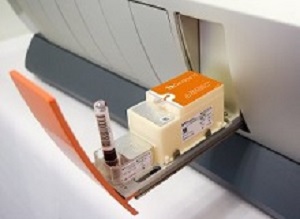 A new blood test seems to perform as well as, if not better than, traditional blood cultures at detecting the candidemia infection that commonly strikes hospital patients.
A new blood test seems to perform as well as, if not better than, traditional blood cultures at detecting the candidemia infection that commonly strikes hospital patients.
The T2Candida Panel is the first diagnostic test for candidemia – a type of bloodstream infection caused by Candida yeast – that has been cleared by the US Food and Drug Administration and doesn't require culturing a blood sample from the patient to see what grows. The trial, named DIRECT2, was funded by T2 Biosystems, the company that makes the panel, which is used by UPMC.
"There are many advantages to quickly diagnosing the specific type of infection a patient has," said lead author Dr Cornelius J Clancy, associate professor of medicine in the University of Pittsburgh's division of infectious diseases, and director of the mycology programme. "With an accurate diagnosis, we can start the patient on the correct medication for the type of infection he or she has, which will hopefully allow us to stop the infection before it spreads, but also keep us from giving the patient a drug that won't work and potentially contributing to drug resistance. For candidemia, we know that the shorter the time to administering an active antifungal medication to a patient, the higher the survival rate. "
Candidemia is among the four most common bloodstream infections in US hospitals, and Candida are the third most common cause of infections in intensive care units. The mortality rate among patients with candidemia is 40%. Blood cultures fail to detect yeast in approximately 50% of Candida infections, and typically take two to three days for positive results to be apparent.
The T2Candida Panel involves putting a small vial of blood from the patient into a desktop machine that uses magnetic resonance to scan the blood for the five most common Candida species. Positive or negative results are available within five hours.
From 14 US hospitals, including UPMC, Clancy's team enrolled 152 patients who had been diagnosed with candidemia through a blood culture. On average, it took nearly two days for the culture to identify that the patient had candidemia, and another day-and-a-half to specify which strain of Candida.
In the trial, the T2Candida test was positive in 89% of patients at the time of a positive blood culture for Candida. The T2Candida Panel was significantly more likely to be positive than blood cultures in patients with recent candidemia, in particular those patients who were being treated with antifungal drugs.
While the T2Candida Panel performed well in the trial, Clancy says there were limitations, including the fact that the study didn't assess whether T2Candida shortens time to starting antifungal treatment or improves patient outcomes.
"Our trial demonstrates that the T2Candida Panel is an important advance in the diagnosis of candidemia," said Clancy. "The next steps should be evaluating it in direct clinical practice and determining if its use truly speeds up antifungal treatment, cuts unnecessary drug prescribing, results in better patient outcomes and is cost-effective, and identifies large numbers of candidemia cases that are currently not detected by blood cultures."
T2 Biosystems provided assistance with the study design and compiled data from each institution in a central database. The study authors performed data and statistical analyses and prepared the manuscript without assistance from the company.
Additional authors on this study are from the University of Alabama Birmingham Hospital; the Henry Ford Health System; the Albany Medical College; the MD Anderson Cancer Centre; the University of California Davis Medical Centre; the University of Houston; Cooper University Hospital; the University of Kentucky Medical Centre; the University of Arkansas Medical System; Emory Healthcare; the University of Texas Health Science Centre; the University of California San Francisco Medical Centre; the St Peters Healthcare System; and Brown University.
Abstract
Background: Blood cultures are approximately 50% sensitive for diagnosing invasive candidiasis. The T2Candida nanodiagnostic panel uses T2 magnetic resonance and a dedicated instrument to detect Candida directly within whole blood samples.
Methods: Patients with Candida albicans, Candida glabrata, Candida parapsilosis, Candida tropicalis, or Candida krusei candidemia were identified at 14 centers using diagnostic blood cultures (dBCs). Follow-up blood samples were collected concurrently for testing by T2Candida and companion cultures (cBCs). T2Candida results are reported qualitatively for C. albicans/C. tropicalis, C. glabrata/C. krusei, and C. parapsilosis. T2Candida and cBCs were positive if they detected a species present in the dBC.
Results: Median time between collection of dBC and T2Candida/cBC samples in 152 patients was 55.5 hours (range, 16.4–148.4). T2Candida and cBCs were positive in 45% (69/152) and 24% (36/152) of patients, respectively (P < .0001). T2Candida clinical sensitivity was 89%, as positive results were obtained in 32/36 patients with positive cBCs. Combined test results were both positive (T2+/cBC+), 21% (32/152); T2+/cBC−, 24% (37/152); T2−/cBC+, 3% (4/152); and T2−/cBC−, 52% (79/152). Prior antifungal therapy, neutropenia, and C. albicans candidemia were independently associated with T2Candida positivity and T2+/cBC− results (P values < .05).
Conclusions: T2Candida was sensitive for diagnosing candidemia at the time of positive blood cultures. In patients receiving antifungal therapy, T2Candida identified bloodstream infections that were missed by cBCs. T2Candida may improve care by shortening times to Candida detection and species identification compared to blood cultures, retaining sensitivity during antifungal therapy and rendering active candidemia unlikely if results are negative.
Authors
Cornelius J Clancy, Peter G Pappas, Jose Vazquez, Marc A Judson, Dimitrios P Kontoyiannis, George R Thompson, Kevin W Garey, Annette Reboli, Richard N Greenberg, Senu Apewokin, G Marshall Lyon, Luis Ostrosky-Zeichner, Alan H B Wu, Ellis Tobin, M Hong Nguyen, Angela M Caliendo
[link url="http://www.upmc.com/media/NewsReleases/2018/Pages/clancy-candida.aspx"]University of Pittsburgh Schools of the Health Sciences material[/link]
[link url="https://academic.oup.com/cid/advance-article-abstract/doi/10.1093/cid/cix1095/4846895?redirectedFrom=fulltext"]Clinical Infectious Diseases abstract[/link]
